This manual is a provisional version only.
User Manual
Provisional version only (V1/English)
1
�
This manual is a provisional version only.
C O N T E N T S
3
5
7
10
12
14
19
20
20
20
22
23
23
24
25
25
25
26
27
27
27
27
27
27
27
28
28
28
28
29
Sensor Unit & digital capture 30
32
The control panel
System requirements
Shooting
Using compact flash cards
Working with the Imagebank CF
Working with a standard FireWire disk
Working tethered
Working with media and batches
Using Instant Approval Architecture
Viewing, deleting and transferring images
Preview modes
Deleting images
Transferring images
Working with the menus
Menu system overview
White balance settings
User inter face settings
Display settings
Storage settings
Default approval status setting
Miscellaneous settings
Menu shortcuts
Care and maintenance
Light Metering &
Exposure Control
Metering method
Exposure method
Manual exposure mode
Automatic exposure mode
AE- L button
Exposure compensation
General Functions
Power - ON
Power - Standby
Power - OFF
Manual focus
Manual focus mode
Autofocus override in manual mode
2
34
35
36
37
37
38
40
43
46
48
51
52
53
55
63
65
67
68
71
73
75
76
79
80
81
81
82
83
84
85
86
86
86
86
87
87
Introduction
Parts & Components
Quick Start
Function Control & Display
Grip LCD
Viewfinder LCD
Camera Body
Carrying strap
Batteries
Rechargeable battery grip
Viewfinder screen
Accessory connection
PC-connector
Viewfinder
Parts & Components
Attaching and
removing the viewfinder
Eyepiece adjustment
Lenses
Parts & Components
Attaching a lens
Removing a lens
Lens cap
Filters and accessories
Lens shades
Shutter and aperture control
Depth-of-field calculation
Depth-of-field / visual preview
Infrared focus settings
Focusing aid
CF adapter
Autofocus
Single Shot
Continuous
Autofocus mode
Drive
Single
Continuous
Profiles
Making a profile
Changing a profile name
Advanced Features
General overview of camera menu
Self Timer
Bracketing
Interval
Settings
Custom Options
Customizable button function list
Image Info
System status
Flash
Flash measure
87
87
88
88
89
89
89
90
90
91
92
93
94
96
98
99
99
103
104
106
107
110
Optional Accessories
111
Appendix
Glossary
Technical specifications
113
114
118
Equipment care, service
and guarantee
122
�
This manual is a provisional version only.
Congratulations!
Welcome to the Hasselblad H System.
The H2D adds the ability to utilize the latest advancements in digital backs, increased mo-
bility, integrated power, and improved image quality. The H2D is the most advanced digital
medium-format photography platform on the market today, and a worthy addition to the
famed Hasselblad line.
The specifications and capabilities of the H system exceed the demands of most photo-
graphers. This allows the system to expand and develop. It’s one of the reasons that so many
professional photographers around the world are discovering, or re-discovering, the creative
and professional possibilities provided by the Hasselblad system.
The H system is the result of the most intensive technical development programme ever un-
dertaken by Hasselblad, the most prestigious medium-format camera manufacturer in the
world. It reflects an unprecedented wealth of knowledge and experience tightly interwoven
with the latest technological developments that combined to produce an unrivalled world-
class creative tool for the discerning photographer.
Hasselblad had its beginnings during the last fifty years of the last millennium. Within twenty
years it was present as mankind took the first small step on the moon. Now, Hasselblad makes
its own giant leap forwards into the future. A new foundation on which to build, ensuring the
utmost in image-quality, handling and versatility resulting from the most reliable and effi-
cient solutions to meet photographers’ expectations.
The H system presents a list of features coloured by superlatives. What was once considered
optional is now integral. The potential of this outstanding professional equipment straight
out of the box is tremendous.
But there is no trade-off in quality for the sake of the latest technology. The three pillars of
the Hasselblad reputation remain: Reliability, Versatility, Interchangeability. Stainless steel
and aluminium for no-nonsense professional use and durability. Silicon chip control for basic
practical support as well as sophisticated facilities to meet all demands. A system to trust and
build on, that will develop and grow in pace with tomorrow’s discoveries.
The list of features is long, varied and comprehensive. For example: automatic focus with
instant manual override, dot-matrix LCDs, rapid button and control wheel user interface,
integral grip, integral fill-flash, very bright OLED on sensor unit, multi-mode exposure meter-
3
�
This manual is a provisional version only.
ing, TTL flash control, capable of saving to internal CF cards and external storage devices,
presentation of digital information such as histograms and grey balance on the LCD, ex-
tremely accurate electronic leaf shutter, flash sync at all shutter speeds to 1/800s, eyeline
viewfinder with 100% view, dot matrix viewfinder LCD, lithium or rechargeable battery op-
tions, shutter speeds from 32 seconds to 1/800s, user customization of functions. And that’s
not all! Bracketing, interval timer, rapid access user button, flash measure, integral diopter
adjustment in viewfinder, zone system capability, time-lapse photography, customized
profiles and so on.
In addition, the H2D has a format allowing for digital capture with sensors more than twice the
physical size of today’s 35mm sensors. The sensor is therefore capable of using more and larger
pixels, which secure a high-end image quality in terms of moiré free colour rendering without
gradation break-ups in even the finest highlight areas or noise in the shadows.
And, apart from the practical aspects, the H2D also exudes a feeling of superb design and ergo-
nomics that makes the camera a pleasure to own as well as use. For handling and convenience
of use it is second to none.
So Hasselblad, the most distinguished pioneer in medium-format photography, yet again
takes the vanguard position. We are confident that you are going to incorporate this camera
inseparably into your photographic life. We are also confident that you are going to produce
images you are proud of. Some of these will remain as a documentation of the history of our
world, perhaps even beyond. That’s how it is with Hasselblad.
The primary goal of all camera development is of course the seamless and unobtrusive produc-
tion of superb images, regardless of situation. The H2D has abilities and features that you may
not think you need, yet. Each individual has their own way of working. But the H2D has tremen-
dous scope for fine-tuning your technique possibly beyond your present ambitions .
The Quick Start Guide should have you up and running in minutes. The H2D will function equal-
ly well as an automatic point-and-shoot or as a total-control, ultra-professional instrument.
The user manual is intended to be the standard reference manual. In it you will find full user
descriptions, LCD charts, specifications, etc.
Take your time to learn the intricacies and potentials of the H2D. Go at your own pace and ex-
plore the possibilities when you feel ready for the next step. Results will be good from the word
go, that’s guaranteed, but when you want to make improvements or work more efficiently per-
haps, the H2D can provide support.
The supreme Hasselblad potential is there, it’s up to you to exploit it!
Finally, please check occasionally on the Hasselblad website — www.hasselblad.com — for any updates
regarding user instructions, changes, news, or other information concerning the H system. If you have no
Internet access, please contact your Hasselblad dealer or distributor for the latest information.
4
�
What’s in the box
This manual is a provisional version only.
Your new Hasselblad camera may have been supplied in kit form or as separate items. There are a number of possible combi-
nations depending on factors such as offers, bundles etc. Please ensure that all the items noted on the accompanying packing
information have been supplied and are correct.
Contact your Hasselblad dealer or distributor immediately if anything is missing or seems faulty in any way, quoting the serial
numbers and purchase details where appropriate.
Familiarise yourself with the various parts and components. Leave protective covers on as much as possible and avoid touching
glass surfaces and inserting fingers into the camera body. The H2D has a robust construction and is capable of withstanding
fairly rough treatment but nevertheless is a precision instrument and will serve you longer if treated with respect from the begin-
ning.
Please keep purchase details and the warranty in a safe place.
5
�
This manual is a provisional version only.
Quick Start
1
This section is a quick start guide to assembling and
preparing your new H2D. From separate items, the
assembly process should take no more than sev-
eral minutes to complete and when the battery is
charged you will be able to take simple and straight-
forward photographs immediately.
All the information is repeated later on in the man-
ual, as well as much more in-depth information,
under the relevant sections and headings for easier
search access.
6
�
This manual is a provisional version only.
11
3
2
1
3
5
7
9
11
2
4
6
8
10
12
2
1
H2D
An H2D can be used in a variety of ways but for simplicity’s sake below is a descrip-
tion of how to use it with a CF card. Naturally you can skip this section if you wish and
go directly to the appropriate section in this manual regarding tethered use etc.
1. Remove the battery by depressing the battery holder button
and simultaneously swinging the battery holder retaining
lever down until it stops. Pull battery downwards.
2. Choose the appropriate plug for the charger.
3. Attach the chosen plug by sliding it into position, ensuring
that the two electrical contact prongs on the charger cor-
rectly enter the two contact sockets on the plug attachment.
4.
Insert the jack plug from the battery charger into the socket
on the battery. Insert the battery charger into a standard
(100–240V~ /50–60 Hz) domestic socket. Charge the battery
until the red signal light on the charger flashes.
5. Holding the battery flat against the camera and aligning
the two upper lugs with the slot, slide it back into position
as far as it will go. Swing back the battery holder retaining
lever until it clicks back into place.
6. Remove the front protective cover from the camera body by
keeping the lens release button depressed and rotating the
cover counter-clockwise until it is released.
7. Remove the lens shade by turning it clockwise.
8. Remove the rear lens cap by unscrewing it in a counter-
clockwise direction.
9. Attach the lens to the camera body by firstly aligning the red
index on the lens mount with the red index on the camera
mount. Grip the lens by the metal barrel (not the rubber
focusing ring) and turn it approximately one quarter turn
clockwise until it clicks into place.
10.
Remove the front lens cap by pinching together the two
retaining clips and attach the lens shade to lens by aligning
the indexes and turning the shade clockwise a quarter turn.
11. Remove the top protective cover from the viewfinder screen
location on the camera body by lifting a corner.
12. Remove the protective cover from the viewfinder by depress-
ing the viewfinder release button.
7
�
13
15
17
19
21
14
16
18
20
B
A
This manual is a provisional version only.
13. While holding the viewfinder at a slight angle, locate the
front section into place on the front edge of the viewfinder
screen recess in the camera body ensuring the central locat-
ing lug and databus interface are positioned correctly. Swing
the viewfinder downwards and press firmly until it clicks into
place. Ensure that both sides of the viewfinder are seated
correctly.
14. Point the camera at a smooth toned area. Turn the eyesight
adjustment dial until you achieve optimum sharpness of the
markings on the viewfinder screen.
15. Open the card-holder cover on the sensor unit by insert-
ing your fingernail into the slot at the front of the door and
swinging it open.
16. Hold the compact-flash card so that the connector holes face
into the slot in the sensor unit, with the brand label facing in
the same direction as the sensor unit preview screen.
17. Gently press the card into the slot. If you encounter resistance,
it might be because you are holding the card backwards or
upside down. Experiment until you find the orientation that
allows the card to slide in easily.
18. When the card is able to drop very easily nearly all the way
into the sensor unit, then you are doing it right. Once you
have achieved this, press the card firmly into place until it
sinks another couple of millimeters into the sensor unit and is
held fast. Swing the side panel door shut again.
..........................................................................
The camera is now complete. If you press the ON.OFF
button A for half a second, the camera will activate. If
the camera enters STANDBY mode (the LCD screen on
the grip will show the H2D symbol only), reactivate it
by pressing the shutter release button B halfway (or
the ON.OFF button).
You can now explore the menus, buttons, control
wheels, etc observing the changes on the LCD on the
grip as well as the LCD in the viewfinder.
..........................................................................
19.
Click the ON.OFF button. The LCD then displays the Profile
screen.
20. Turn either the front or rear control wheel until ‘Standard’ is
highlighted.
21. Press the AF / Load button.
That’s it!
Your Hasselblad H2D is now operational in fully automatic mode. In aver-
age lighting conditions the camera will act as a point and shoot camera
producing extremely fine results without the need to touch any other but-
ton than the shutter release!
8
�

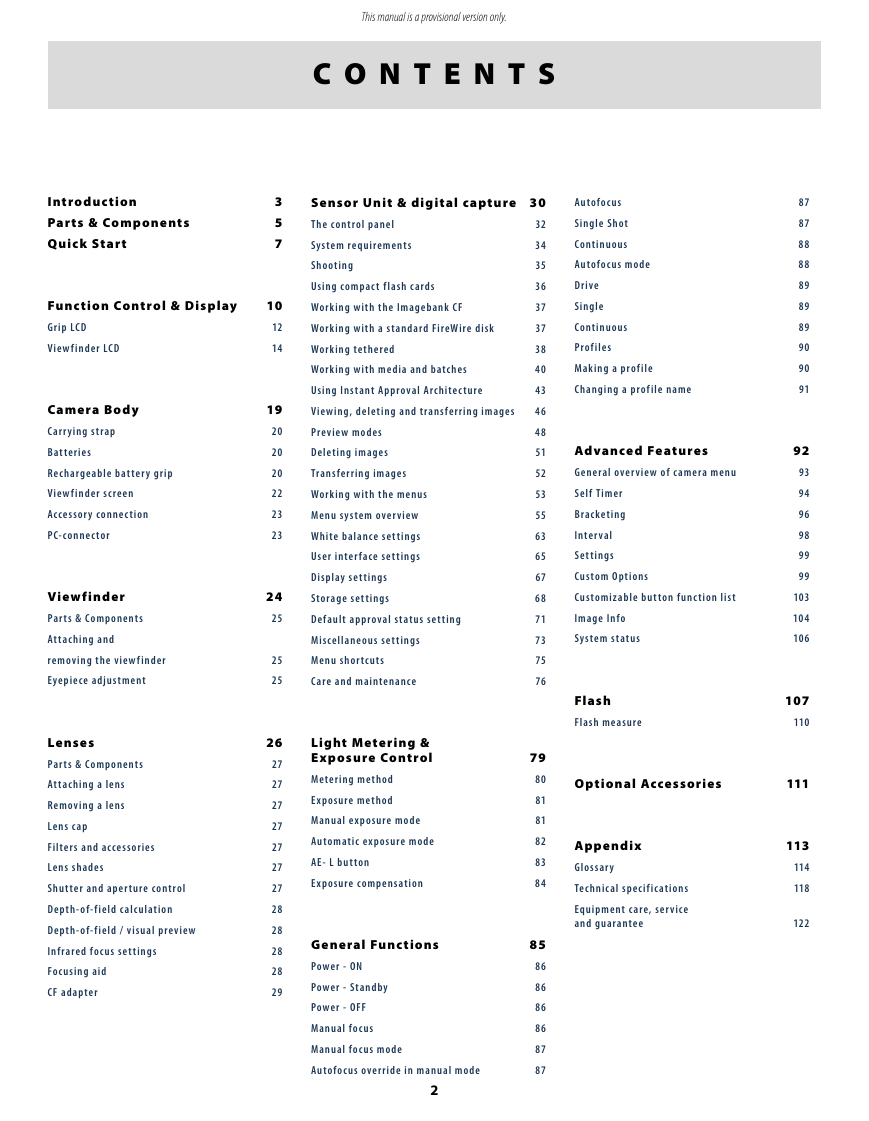
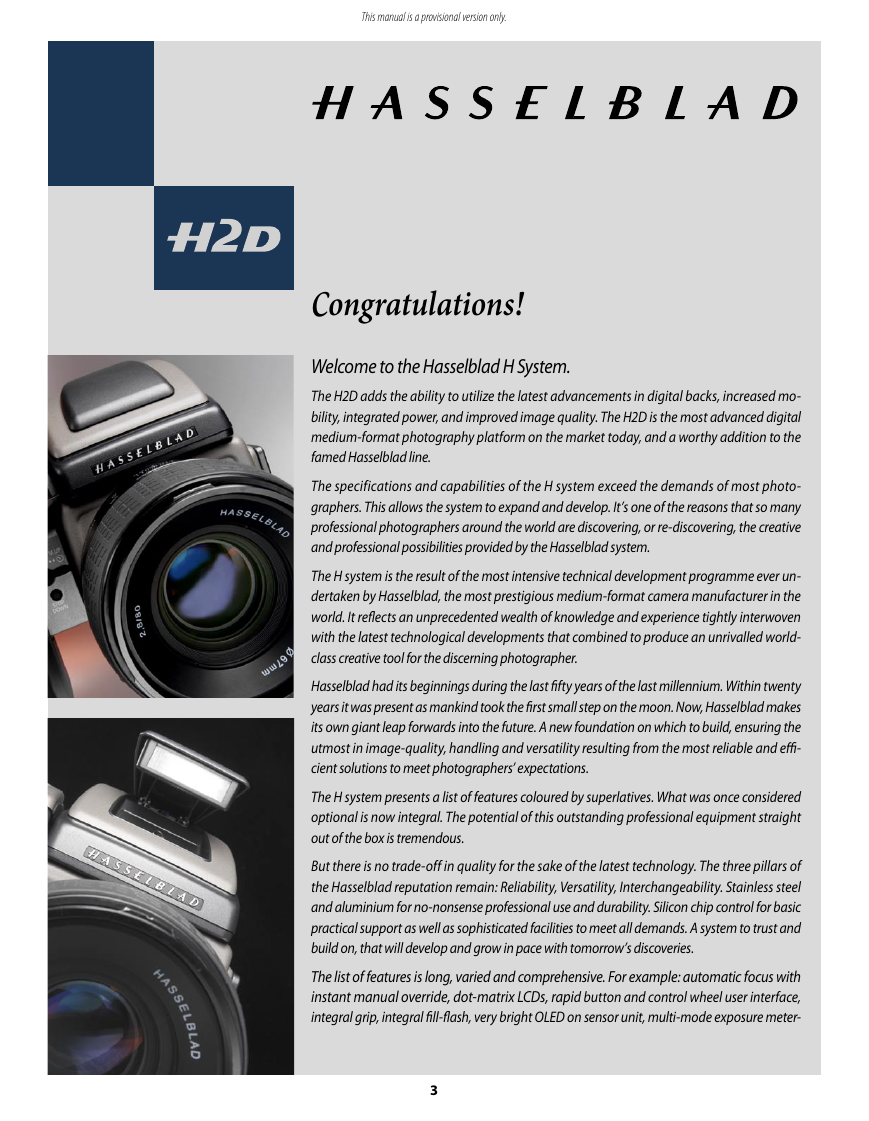

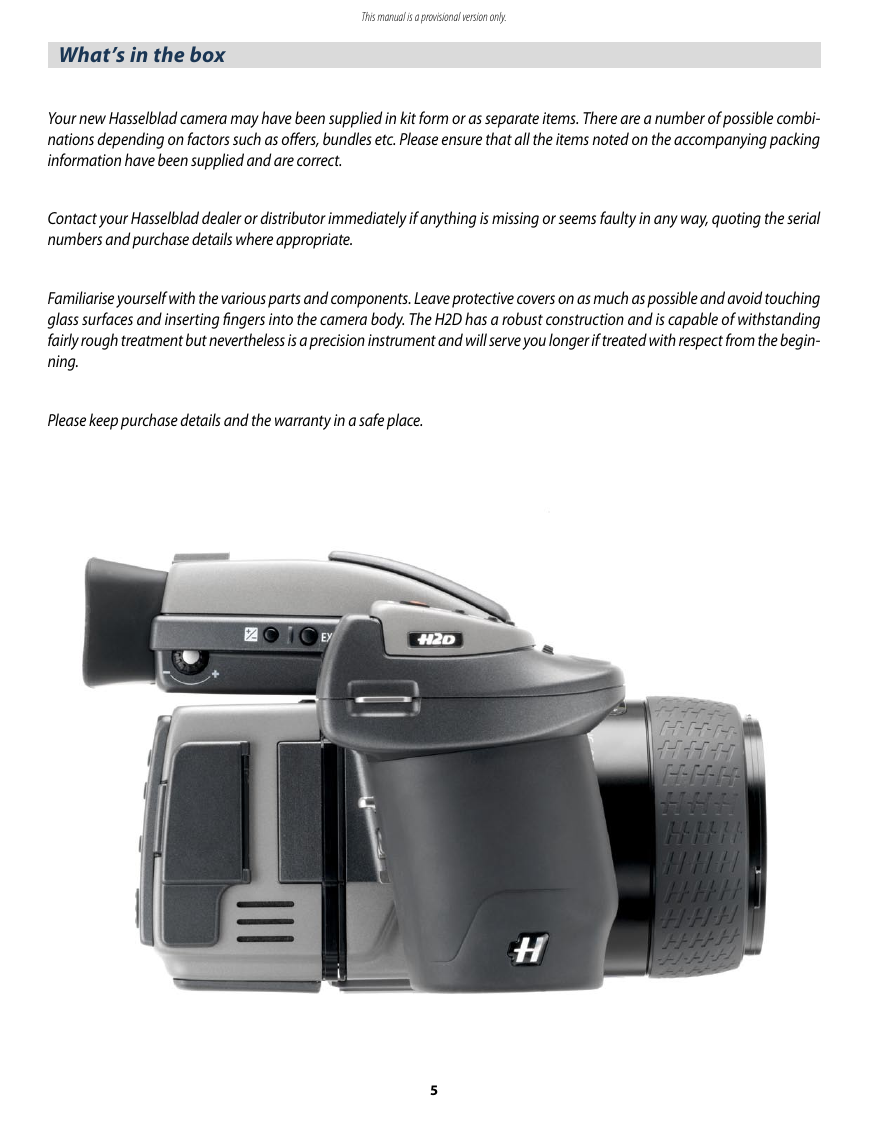

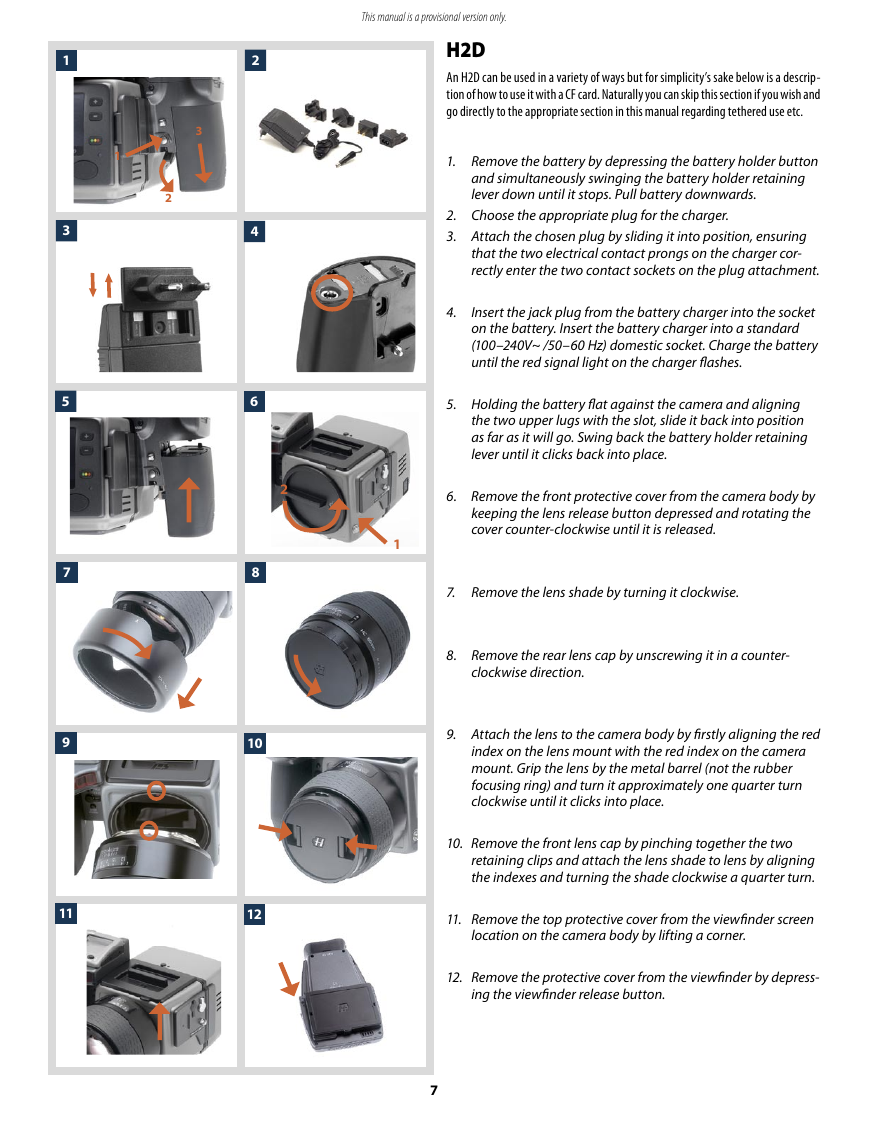
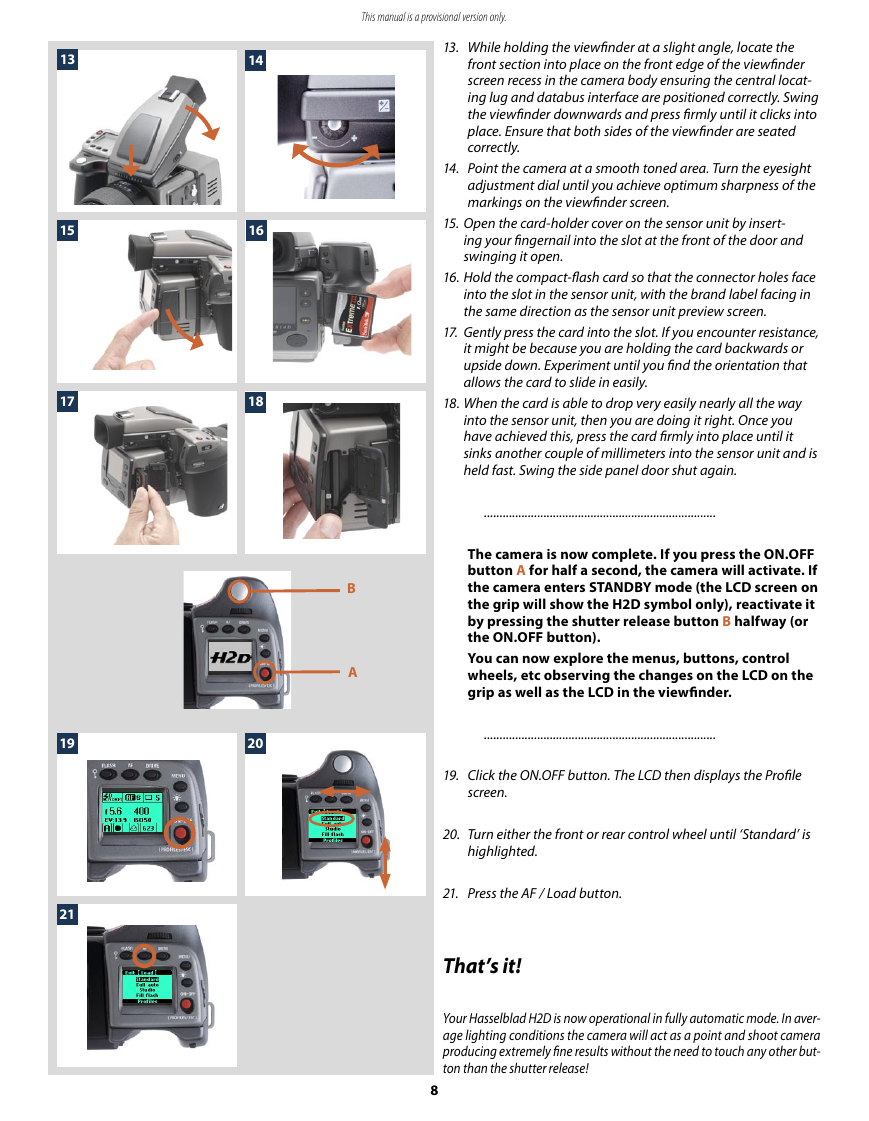








 2023年江西萍乡中考道德与法治真题及答案.doc
2023年江西萍乡中考道德与法治真题及答案.doc 2012年重庆南川中考生物真题及答案.doc
2012年重庆南川中考生物真题及答案.doc 2013年江西师范大学地理学综合及文艺理论基础考研真题.doc
2013年江西师范大学地理学综合及文艺理论基础考研真题.doc 2020年四川甘孜小升初语文真题及答案I卷.doc
2020年四川甘孜小升初语文真题及答案I卷.doc 2020年注册岩土工程师专业基础考试真题及答案.doc
2020年注册岩土工程师专业基础考试真题及答案.doc 2023-2024学年福建省厦门市九年级上学期数学月考试题及答案.doc
2023-2024学年福建省厦门市九年级上学期数学月考试题及答案.doc 2021-2022学年辽宁省沈阳市大东区九年级上学期语文期末试题及答案.doc
2021-2022学年辽宁省沈阳市大东区九年级上学期语文期末试题及答案.doc 2022-2023学年北京东城区初三第一学期物理期末试卷及答案.doc
2022-2023学年北京东城区初三第一学期物理期末试卷及答案.doc 2018上半年江西教师资格初中地理学科知识与教学能力真题及答案.doc
2018上半年江西教师资格初中地理学科知识与教学能力真题及答案.doc 2012年河北国家公务员申论考试真题及答案-省级.doc
2012年河北国家公务员申论考试真题及答案-省级.doc 2020-2021学年江苏省扬州市江都区邵樊片九年级上学期数学第一次质量检测试题及答案.doc
2020-2021学年江苏省扬州市江都区邵樊片九年级上学期数学第一次质量检测试题及答案.doc 2022下半年黑龙江教师资格证中学综合素质真题及答案.doc
2022下半年黑龙江教师资格证中学综合素质真题及答案.doc